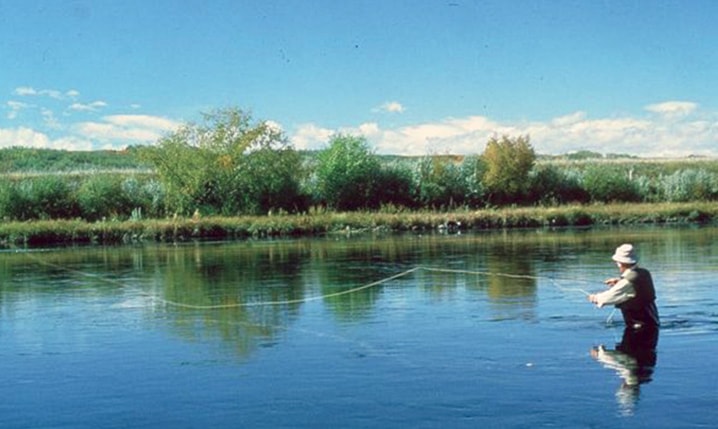The tsunami of reader comment about the terrible 2013 fishing season almost exceeds the June floods that caused it.
From the south, Jim McLennan, angling author and teacher, sums it up for us all: “It’s a tough summer down here. Every time I go somewhere, it’s like going to some place I’ve never been before.
Don’t know if the fish are there or not (there are virtually no rising fish to help with that), and the fishing where I’ve been has been generally lousy.”
Ironically, readers have reported good southern fishing on the hardest-hit river of all, the lower Bow, and also on the Crowsnest River even further south.
Too often are heard discouraging words from west Central Alberta: high, muddy rivers and streams, impossible to wade, into the middle of August, bridges out (such as over the South Ram River) and slow fishing for tiny trout.
The only good fishing reports come from the few spring, or muskeg, creeks, particularly Shunda Creek.
In many recent years, the season-saver has been the fall fishing, and the signs are that it will be again this year: rains are decreasing in intensity and duration, waters are gradually lowering and clearing, and the light is mimicking pre-spring equinox colour and intensity as we approach the autumnal equinox.
The fish also notice that fall is coming, start feeding up for winter and the brown and bull trout are on the move upstream to the spawning gravels. The wise angler will act as if the fishing season is just starting.
Looking back on more than 65 years of angling, now that I have had to quit, I miss the fall fishing most, even more than the July-into-August night fishing. Fall fishing, at its best, can be fascinating in the variety of behaviours of the trout in response to the seasonal smorgasbord of the insects on which they feed.
There seems to be an abundance of the fall “knuckleballs” of the insect world — grasshoppers, dragonflies, “beetles,” water boatmen and backswimmers — which flit, dip and dive, so that the trout have as hard a time catching or hitting them as any baseball player does with a knuckleball, resulting in exciting and splashy rises by big trout.
There should be good hatches of the dipsy-doodliest of all fish fodder, our largest caddis fly, the fall, or October caddis.
The pupa of this species builds a stone case and securely glues it to big underwater rocks, thus the species survives big floods that can seriously reduce the populations of other aquatic insect species.
I once sprained an ankle chasing and swinging my insect net at knuckling adult fall caddis flies to get some for photographs.
At least I caught a few; I have never seen a trout catch one, but they never quit trying for those succulent, orange-bodied packets of protein.
Fall’s comedy gig is finding a “dragon-eater,” a big trout beside an overhung cut bank, leaping repeatedly, sometimes even grounding itself, as it tries to catch dragonflies flying close to the bank in search of their own insect prey.
In my experience, huge, hard-to-cast dragonfly imitations are not necessary. Slap a big hopper imitation down as close as you can get it to the frustrated trout’s position and it will likely charge out and eat it.
The slow pitch, technical side of the fall fishing menu is hunting for quiet rises, so sneaky that you always wonder if you really saw them.
These are usually ant-eating trout, and there are too many ants this year. I favour a black, white-winged poly ant imitation in sizes No. 18 to 22. Trout like the tart ant flavour so much that they will often cruise several metres to intercept the little “blip” of an ant imitation hitting the water.
At this time of year, you can always encounter trout rising quietly to hatches of our tiniest mayflies: blue-winged olives on dull, cloudy, drizzly, even snowy days; tricorythodes mayflies on sunny days, from early morning (for the duns) to mid-morning for the fall of mated spinners.
This is highly technical fishing, and not for gents of a certain age with eyes and arms too short to thread the finest of leader tippet through the tiny eyes of No. 20 to 24 hooks, only to find the leader snaps, or the hook straightens out on each big trout hooked.
Tips: I did well when I started tying my most miniscule flies on Orvis Big Eye hooks, and I started hooking and landing good trout during trico hatches pitching a “changeup” of a lurid No. 18 scarlet-bodied flying ant pattern, as suggested by Leigh Perkins, then president and CEO of Orvis, on the fall day the Perkins Pool on Prairie Creek got its name.
Too many anglers give up too soon on a bad season and miss out on what is often the best fishing of the year … in the fall.
Bob Scammell is an award-winning columnist who lives in Red Deer. He can be reached at bscam@telusplanet.net.
